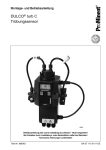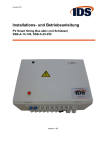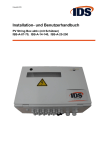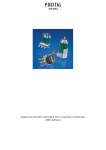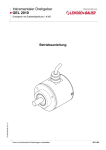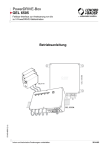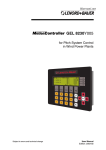Download GEL 207 / 208 / 209 / 219 Betriebsanleitung Operating Instructions
Transcript
GEL 207 / 208 / 209 / 219 Magnetisch-inkrementale Drehimpulsgeber Magnetic Incremental Encoders Betriebsanleitung Operating Instructions Inhalt Contents 1. 2. 3. 4. 5. 6. 1. 2. 3. 4. 5. 6. Allgemeine Sicherheitshinweise ......... 3 Einleitung ........................................... 4 Typenschlüssel .................................. 5 Mechanischer Einbau......................... 6 Elektrischer Anschluss ....................... 8 Technische Daten ............................ 10 Irrtum und technische Änderungen vorbehalten General safety instructions .............. 13 Introduction...................................... 14 Type code........................................ 15 Mechanical assembly ...................... 16 Electrical connection........................ 18 Technical Data................................. 20 Right to technical changes and errors reserved. 2006-11 Doc. No. DS19-207 Lenord, Bauer & Co. GmbH Dohlenstrasse 32 46145 Oberhausen • Germany Fon: +49 (0)208 9963-0 • Fax: +49 (0)208 676292 Internet: http://www.lenord.de • E-Mail: [email protected] 2 GEL 207…219 Deutsch 1. Allgemeine Sicherheitshinweise Zur Erhaltung der Funktionsfähigkeit des Drehimpulsgebers unbedingt folgende Punkte beachten: • Drehimpulsgeber nur über eine flexible Kupplung mit der Antriebswelle verbinden • Drehimpulsgeber vor mechanischen Beschädigungen schützen (bei Einbau und Betrieb, siehe dazu die Handhabungshinweise in Kapitel 4). • Einbau-, Anschluss- und Service-Arbeiten nur von qualifiziertem und geschultem Fachpersonal durchführen lassen, unter Berücksichtigung der einschlägigen Unfallverhütungs- und Sicherheitsvorschriften sowie der Angaben in dieser Betriebsanleitung. Drehimpulsgeber nicht öffnen oder auseinander nehmen. Notwendige Reparaturen dürfen nur von LENORD+BAUER oder einer davon ausdrücklich ermächtigten Stelle durchgeführt werden. • Die in der Produktdokumentation angegeben Grenzwerte unbedingt einhalten. • Buchstabenanordnung in der Steckerbelegung (Kapitel 5) beachten: Ein häufig auftretender Fehler ist das spiegelbildliche Anschließen von Leitungen an den Gegenstecker. Drehimpulsgeber nur bestimmungsgemäß verwenden: Die Drehimpulsgeber GEL 207…219 sind ausschließlich für Messaufgaben im industriellen und gewerblichen Bereich bestimmt. Mit ihnen können Positionen, Längen, Winkel oder Drehzahlen gemessen werden. Sie gelten als Zubehörteil einer Anlage und erfordern den Anschluss an eine spezielle Auswertelektronik, wie sie ein Positioniercontroller oder ein elektronischer Zähler enthält. Zur bestimmungsgemäßen Verwendung gehört auch, dass alle in der Produktdokumentation gegebenen Hinweise beachtet werden. Eine andere oder darüber hinausgehende Verwendung gilt als nicht bestimmungsgemäß. Für hieraus entstehende Schäden haftet die Firma LENORD, BAUER & CO. GMBH nicht. Hinweis in eigener Sache Die Betriebsanleitung wurde mit größter Sorgfalt erstellt. Es kann jedoch keine Gewähr für Fehlerfreiheit übernommen werden. Die Betriebsanleitung ist bestimmt für den Betreiber bzw. Anlagenbauer sowie dessen Personal. Bitte bewahren Sie sie sorgfältig auf, so dass sie auch für einen möglichen späteren Serviceeinsatz am Drehimpulsgeber zur Verfügung steht. Bei Weitergabe des Gebers an Dritte bitte auch diese Betriebsanleitung mitgeben. GEL 207…219 3 Deutsch 2. Einleitung Einsatzbereich Die Drehimpulsgeber GEL 207…219 sind robuste Signalgeber für die Messung von Rotationsbewegungen oder Positionen. Sie sind für den Einsatz in rauer Umgebung geeignet, da sie eine hohe Beständigkeit gegen Betauung, Spritz- und Kondenswasser sowie einen großen Temperaturbereich von 0 °C bis +70 °C, optional sogar von -20 °C bis +85 °C aufweisen. Als Ausgangssignale dienen zwei um 90° phasenversetzte Rechtecksignale und – je nach Ausführung – deren inverse Signale, wodurch eine eindeutige Richtungserkennung und eine hohe Datensicherheit gegeben sind. Ein optionaler Referenzimpuls kann zum Kalibrieren der Anlage herangezogen werden. Aufbau und Ausführungen Die Drehimpulsgeber besitzen ein berührungsloses magnetisches Abtastsystem (Magnetfeldsensor) und ein Zahnrad als Maßverkörperung. Sie sind mit verschiedenen Wellendurchmessern und -längen sowie mit verschiedenen axialen und radialen Stecker- oder Kabelabgängen und unterschiedlichen Flanschausführungen lieferbar. Die Spannungsversorgung beträgt je nach Typ 5 V oder 10…30 V DC. Optionen enthalten z.B. einen Kondenswasserstopfen oder einen zusätzlichen Feuchtigkeits- und Vibrationsschutz. Funktionsprinzip Das Magnetfeld des Sensors im Drehimpulsgeber wird durch das sich drehende Zahnrad (Maßverkörperung) verändert. Die Magnetfeldänderung wird vom Sensor ausgewertet und in entsprechende sinusförmige Messsignale umgesetzt. Eine interne Auswertelektronik generiert daraus die rechteckförmigen Ausgangssignale. Signalmuster a) V, VN 360° el. Spur 1 90° UB 10 ... 30 VDC Spur 2 US HTL tF Spur N (Option) tF: Flankenabstand bei 200 kHz ≥ 0,6 µs (gilt für alle Signalmuster) b) T, TN; U, UN; X, XN Spur 1 Spur 1 Spur 2 T(N) U(N) X(N) UB 5 VDC ± 5% 10 ... 30 VDC 10 ... 30 VDC US TTL TTL HTL Spur 2 Spur N (Option) Spur N Signaldarstellung für Rechtslauf; UB = Betriebsspannung, US = Signalamplitude 4 GEL 207…219 Deutsch 3. Typenschlüssel GEL ___ - _ _ _____ _ _ _ _ Typ (siehe Maßbilder Seite 7) 207 208 209 219 mit Synchronflansch mit Klemmflansch mit Lagerbock und erhöhter Wellenbelastung mit Rechteckflansch und erhöhter Wellenbelastung Signalmuster (siehe Seite 4) T U V X UB = 5 VDC, Logikpegel TTL UB = 10…30 VDC, Logikpegel TTL UB = 10…30 VDC, Logikpegel HTL UB = 10…30 VDC, Logikpegel HTL Referenzsignal – N ohne Referenzsignal (Standard) mit Referenzsignal (Option) Impulszahl (Inkremente pro Umdrehung) 10 … 136.192 Stecker/Kabelabgang A B C D 6-poliger Stecker, axial 6-poliger Stecker, radial 12-poliger Stecker, axial 12-poliger Stecker, radial F G H I 6-adriges Kabel, axial 6-adriges Kabel, radial 10-adriges Kabel, axial 10-adriges Kabel, radial Wellendurchmesser/Länge (in mm) 0 1 2 6/10, Standard (nur GEL 207) 10/20, Standard (nur GEL 208) 16/28, Standard (nur GEL 209/219) 6/10 (nur GEL 208) 8/27 (nur GEL 207/208) 4 5 6 7 10/20 (nur GEL 207) 10/20 Scheibenfeder (nur GEL 207/208) 12/27 (nur GEL 207/208) 12/27 Scheibenfeder (nur GEL 207/208) Schutz der Elektronik 0 1 2 ohne zusätzlichen Schutz Feuchtigkeitsschutz Vibrationsschutz 3 4 5 Feuchtigkeits- und Vibrationsschutz Feuchtigkeitsschutz und Kondenswasserauslass Feuchtigkeits- und Vibrationsschutz und Kondenswasserauslass Temperaturbereich 1 0 °C … +70 °C 3 -20 °C … +85 °C (Option) GEL 207…219 5 Deutsch 4. Mechanischer Einbau Wichtige Hinweise Bitte sorgen Sie bei der Montage, der Inbetriebnahme und im laufenden Betrieb dafür, dass alle von uns definierten Spezifikationen (z. B. Umgebungsbedingungen, Versorgungsspannung, Wellenbewegung ...) und die geltenden Unfallverhütungsvorschriften eingehalten werden. Die Nichteinhaltung und die Nichtbeachtung der folgenden Hinweise können zu Fehlfunktionen führen. Den Drehimpulsgeber weder teilweise noch ganz öffnen und/oder demontieren. Sie könnten ihn beschädigen und die weitere Funktion beeinträchtigen. Drehimpulsgeber und Antriebswelle nicht mit einer starren Kupplung verbinden. Es könnten zu hohe Kräfte auf die Lagerung ausgeübt werden. Verwenden Sie elastische, aber drehsteife Kupplungen! Sie können solche von uns beziehen (bitte kontaktieren Sie uns für nähere Informationen). Nicht auf das Gehäuse und die Welle schlagen oder treten. Dies könnte zu äußeren und inneren Beschädigungen des Drehimpulsgebers führen. Die Welle nicht anbohren oder anschleifen. Dies könnte Beschädigungen im Inneren des Drehimpulsgeber verursachen. Keine höheren axialen oder radialen Kräfte auf die Welle ausüben, als in den technischen Daten angegeben. Drehimpulsgeber so montieren, dass die Funktion des Gerätes nicht beeinträchtigt wird. Sie können spezielles Montagezubehör von uns beziehen (bitte spezielles Geberzubehör-Datenblatt anfordern). Drehimpulsgeber mit Kondenswasserverschraubung (Sonderausführung) so einbauen, dass der Stopfen nach unten zeigt. Geeignete ESD-Schutzmaßnahmen treffen gemäß DIN EN 100015-1 (CECC 00015-1), siehe Seite 9. 6 GEL 207…219 Deutsch Maßbilder (alle Abmessungen in mm) GEL 207 Synchroflansch D h6 6 8 10 12 L 10 27 20 27 Standard für ← GEL 207 ← GEL 208 GEL 208 Klemmflansch ExzenterKlemmstücke für die Flanschbefestigung und weitere Montageteile lieferbar (siehe Geberzubehör-Datenblatt) GEL 209 Lagerbock GEL 219 Rechteckflansch (Maßbild Kondenswasserauslass siehe Seite 11.) GEL 207…219 7 Deutsch 5. Elektrischer Anschluss Kabel- und Steckerbelegung 9 1 F A B 10 2 8 12 7 11 E D C 6 3 4 6-poliger Stecker 5 12-poliger Stecker Stecker/Kabel 6-polig 12/10-polig C braun 5 weiß – – 6 braun B weiß 8 rosa – – 1 schwarz D grau 3 violett – – 4 gelb F gelb 12 rot A grün 10 blau – – 2 – – – 11 – Signalspannung (US) Signal/Funktion V VN T, U, X TN, UN, XN Spur 1 Spur 1 Spur 1 Spur 1 – – Spur 1 Spur 1 Spur 2 Spur 2 Spur 2 Spur 2 – – Spur 2 Spur 2 – Spur N – Spur N – – – Spur N UB: +10…30 V (U, V, X) oder +5 V ± 5% (T) 0 V (GND, Bezugsmasse) + Sense (UB) – Sense (GND) V/VN, X/XN HTL (10…30 V) T/TN, U/UN TTL (5 V) Erläuterungen: • Kabelabgang: Abschirmung auf der Drehimpulsgeber-Seite nicht angeschlossen • Sense-Funktion: Bei Nichtverwendung die freien Leitungen mit für die Spannungsversorgung nutzen (Halbierung des Spannungsabfalls durch Parallelschaltung) • Nicht aufgeführte Steckeranschlüsse/Kabelfarben sind nicht belegt Maximale Kabellängen Die Angaben beziehen sich auf Kabel vom Typ LiYCY 6 (10) × 0,25 mm2 zwischen Drehimpulsgeber und nachgeschalteter Elektronik. • TTL 1) (T/TN, U/UN) f= L= • HTL (bei UB = 20 V) f = (V/VN, [X/XN]) L= 1) 8 ≤ 100 kHz 200 m ≤ 20 kHz 200 [100] m 200 kHz 145 m 50 kHz 80 [40] m 100 kHz 40 [20] m 200 kHz 20 [10] m Die angegebenen Längen gelten bei Verwendung eines Netzteils mit Sense-Regelung GEL 207…219 Deutsch EGB-Hinweise (Elektrostatisch gefährdete Bauelemente) Wie bei jedem elektronischen Gerät sind auch beim Anschluss der Drehimpulsgeber EGB-Vorsichtsmaßnahmen zu treffen. Grundsätzlich gilt, dass elektronische Baugruppen – insbesondere Steckerstifte und Anschlussdrähte – nur dann berührt werden sollen, wenn dies wegen daran vorzunehmender Arbeiten unvermeidbar ist. Der genaue Umfang der Schutzmaßnahmen richtet sich nach den örtlichen GegebenS T O heiten. Detaillierte Auskunft gibt die EN 100 015-1 (CECC 00015-1). Im Allgemeinen ist eine leitfähige, fachkundig geerdete Arbeitsunterlage in Verbindung mit einem EGB-Armband ausreichend. Es ist erforderlich, die Schutzmaßnahmen in regelmäßigen Abständen auf ihre Wirksamkeit zu überprüfen. EMV-Hinweise P (Elektromagnetische Verträglichkeit) Zur Verbesserung des elektromagnetischen Umfeldes (EMV) bitte folgende Einbauhinweise beachten: ❏ Möglichst nur Stecker mit Metallgehäuse oder einem Gehäuse aus metallisiertem Kunststoff und abgeschirmte Kabel verwenden; den Schirm am Steckergehäuse auflegen ❏ Schirme an beiden Kabelenden möglichst großflächig auflegen ❏ Alle ungeschirmten Leitungen möglichst kurz halten ❏ Erdungsverbindungen möglichst kurz und mit großem Querschnitt ausführen (z. B. induktionsarmes Masseband, Flachbandleiter) optionale ❏ Sollten zwischen den MaPegel-Impuls-Umsetzer (PIU) oder Leitungstreiber (LT) schinen- und ElektronikErdanschlüssen PotentialAuswertPIU, Maschine Geber elektronik LT differenzen bestehen oder auftreten, so ist durch geeignete Maßnahmen dafür zu Potentialaussorgen, dass über den Kabelgleichsleitung Nur bei ungünstigen schirm keine AusgleichsBedingungen wie: - sehr lange Kabel Steuerleitungen ströme fließen können; z. B. - extreme Störpegel Potentialausgleichsleitung mit großem Querschnitt verlegen (siehe Grafik) oder Kabel mit getrennter 2fach-Schirmung verwenden, wobei die Schirme nur auf jeweils einer Seite aufgelegt werden ❏ Signal- und Steuerleitungen räumlich von den Leistungskabeln getrennt verlegen; ist dies nicht möglich, paarig verseilte und geschirmte Leitungen (twisted pair) verwenden und/oder die Geberleitung in einem Eisenrohr verlegen ❏ Die Stromversorgung muss der Installationsart Klasse 0 gemäß Punkt B.3 der EN61000-4-5 von 1995 entsprechen GEL 207…219 9 Deutsch 6. Technische Daten Messschritte pro Umdrehung Auflösung 10 … 136.192 36° … 0,003° Fehlergrenze (für max. Auflösung) 0,14° Elektrische Daten Betriebsspannung UB für Signalmuster (siehe Seite 4) U/UN, V/VN, X/XN T/TN Leistungsaufnahme RL = ∞, UB = 10…30 V DC RL = ∞, UB = 5 V DC Ausgangspegel für Signalmuster T/TN (TTL) Ausgangspegel für Signalmuster U/UN (TTL) Ausgangspegel für Signalmuster V/VN und X/XN (HTL) Ausgangsfrequenz Spitzenausgangsstrom zur Umladung der Kabelkapazität Mechanische Daten max. Betriebsdrehzahl Trägheitsmoment des Rotors max. Winkelbeschleunigung Betriebsdrehmoment Anlaufdrehmoment Maximale Wellenbelastung (Angriffspunkt 15 mm von der Flanschanlage) Zulässige Wellenbewegung Lagerlebensdauer (Umdrehungen) • bei halber Wellenbelastung • bei maximaler Wellenbelastung Wellendurchmesser Flanschausführungen Masse 10 10 … 30 V DC 5 V DC ± 5% ≤ 1,3 W ≤ 1,0 W High: ≥ UB - 1,00 V bei I = 10 mA; ≥ UB - 1,20 V bei I = 30 mA Low: ≤ 0,75 V bei I = 10 mA; ≤ 1,00 V bei I = 30 mA High: ≥ 4,00 V bei I = 10 mA; ≥ 3,85 V bei I = 30 mA Low: ≤ 0,75 V bei I = 10 mA; ≤ 1,00 V bei I = 30 mA High: ≥ UB - 1,80 V bei I = 10 mA; ≥ UB - 2,20 V bei I = 30 mA Low: ≤ 1,15 V bei I = 10 mA; ≤ 1,55 V bei I = 30 mA 0 Hz … 200 kHz 100 mA GEL 207/208 -1 10.000 min GEL 209/219 -1 8.000 min -5 2 7 · 10 kgm extrem hoch, da Welle und Messrad (Stahl) verpresst sind 0,03 Nm (< 0,01 Nm mit Kugellagerabdeckscheibe, Option) 0,05 Nm (0,01 Nm mit Kugellagerabdeckscheibe, Option) 200 N axial 400 N axial 200 N radial 500 N radial Ankopplung über eine flexible Kupplung empfohlen 6 6 12.600 · 10 6 2.000 · 10 6.600 · 10 6 840 · 10 6 / 8 / 10 / 12 mm Synchroflansch (GEL 207), Klemmflansch (GEL 208) ca. 0,5 kg 16 mm Lagerbock (GEL 209), Rechteckflansch (GEL 219) ca. 0,7 kg GEL 207…219 Deutsch Mechanische Daten Gehäuse GEL 207/208 GEL 209/219 Stahl, galvanisch verzinkt und schwarz chromatiert, Durchmesser 58 mm Umweltbedingungen Arbeitstemperaturbereich 0 … +70 °C (Standard); -20 … +85 °C (Option) -20 … +85 °C -40 … +105 °C IP 65; Betriebstemperaturbereich Lagertemperaturbereich Schutzart nach DIN EN 60529 mit Kondenswasserauslass (Option): IP 64 Vibrationsfestigkeit nach DIN EN 60068-2-6 Frequenzbereich Spitzenbeschleunigung Frequenzzyklen Schockfestigkeit nach DIN EN 60068-2-27 Isolationsfestigkeit nach VDE 0660 Teil 500 Ausgabe 08/00 oder DIN EN 60439-1 Elektromagnetische Verträglichkeit Kondenswasserauslass: GEL 207…219 10 … 2.000 Hz 2 100 m/s 10 2 Spitzenbeschleunigung 1.000 m/s , Dauer 11 ms Ri > 1 MΩ, bei einer Prüfspannung von 500 V AC EN 61000-6-1 bis 4 Geber 11 Deutsch Notizen: 12 GEL 207…219 English 1. General safety instructions In order to maintain the encoder's functioning please note the following instructions: • Only use a flexible coupling to connect the encoder to the driving shaft • Protect the encoder from being mechanically damaged when mounting and operating, please observe the handling notes given in chapter 4. • Only skilled personnel are allowed to commission, connect and service these components while following the current regulations for prevention of accidents and safety instructions as well as the information given in this manual. Do not open the encoder nor disassemble it; if repairs are necessary they must only be carried out by LENORD+BAUER personnel or by a person/company expressly authorized by LENORD+BAUER. • Keep to the limit values stated in the product documentation. • Note the orientation of the characters in the connector's pin layout (see chapter 5). A common mistake is a mirror image connection of the lines to the plug pins. Make use of the encoder only as designated: The encoders GEL 207…219 have been exclusively designed for performing measuring tasks in industry. They can be used to measure positions, lengths, angles or speeds. They are considered to be components of a complete system and need to be connected to a special evaluation electronics such as incorporated in a positioning controller or an electronic counter. The designated use requires as well the observance of all instructions listed in the product documentation. Any use other than specified must be considered as non-designated and, consequently, LENORD, BAUER & CO. GMBH cannot be held responsible for any damage resulting from such use. Note These Operating Instructions have been produced with great care. However, no guarantees can be made for possible errors. The Operating Instructions are meant for use by the user or system builder as well as their employees. Please deposit this manual in a safe place for future use, and enclose it with the encoder when passing it on to another user. GEL 207…219 13 English 2. Introduction Scope The encoders GEL 207…219 are highly resistant to harsh environmental conditions and are particularly resistant to the effects of condensation. The high temperature range from 0 °C to +70 °C, optional from -20 °C to +85 °C, ensures functional reliability in a wide range of conditions. The encoder is thus also ideally suited to applications in heavy industry and in outdoor locations. Two 90° phase-shifted rectangular signals and, according to the encoder type, their inverse signals are output by which the direction detection and a high data reliability are realised. Additionally, an optional reference pulse can be used for calibrating the drive. Design The encoders use a contactless magnetic scanning system (magnetic field sensor) and a toothed wheel which serves as measuring scale. Various designs include several shaft diameters and lengths as well as different axial and radial plug and cable outlets and various flange types. The voltage supply is 5 VDC or 10– 30 VDC, according to the encoder type. Optional designs include a condensed-water outlet or other additional protection measures against moisture and vibration. Functional principle The sensor’s magnetic field inside the encoder is changed by the passing of the built-in toothed wheel. The change in the magnetic field is evaluated by the sensor and is converted into sinusoidal measuring signals. An internal interpolation electronic generates the rectangular output signals from the sinusoidal signals. Signal patterns a) V, VN 3 6 0 ° e l. T ra c k 1 9 0 ° U B 1 0 to 3 0 V D C T ra c k 2 tF U S H T L T ra c k N ( o p tio n ) tF: edge distance at 200 kHz ≥ 0.6 µs (valid for all signal patterns) b) T, TN; U, UN; X, XN T ra c k 1 T ra c k 1 T ra c k 2 T (N ) U (N ) X (N ) U B 5 V D C ± 5 % 1 0 to 3 0 V D C 1 0 to 3 0 V D C U S T T L T T L H T L T ra c k 2 T ra c k N ( o p tio n ) T ra c k N Signals shown for clockwise movement; UB = supply voltage, US = signal amplitude 14 GEL 207…219 English 3. Type code GEL ___ - _ _ _____ _ _ _ _ Type (see dimensioned drawings on page 17) 207 208 209 219 with synchro flange with clamp flange with mounting foot and extended shaft load with square flange and extended shaft load Signal pattern (see page 14) T U V X UB = 5 VDC, TTL logic level UB = 10 to 30 VDC, TTL logic level UB = 10 to 30 VDC, HTL logic level UB = 10 to 30 VDC, HTL logic level Reference signal – N no reference signal (standard) with reference signal (option) Pulse number (increments per revolution) 10 to 136,192 Plug/cable outlet A B C D 6-pole plug, axial 6-pole plug, radial 12-pole plug, axial 12-pole plug, radial 6-core cable, axial 6-core cable, radial 10-core cable, axial 10-core cable, radial F G H I Shaft diameter/length (in mm) 0 1 2 4 5 6 7 6/10, standard (only GEL 207) 10/20, standard (only GEL 208) 16/28, standard (only GEL 209/219) 6/10 (only GEL 208) 8/27 (only GEL 207/208) 10/20 (only GEL 207) 10/20 Woodruff key (only GEL 207/208) 12/27 (only GEL 207/208) 12/27 Woodruff key (only GEL 207/208) Additional protection of the electronic 0 1 2 no additional protection moisture protection vibration protection 3 4 5 vibration and moisture protection moisture protection and condensed-water outlet vibration and moisture protection and condensed-water outlet Temperature range 1 0 °C to +70 °C 3 -20 °C to +85 °C (option) GEL 207…219 15 English 4. Mechanical assembly Important notes When mounting, commissioning or during operation, please observe all our specifications (e. g. regarding ambient conditions, supply voltage, shaft movement, etc.) and the currently operative regulations for accident prevention. Should you ignore the instructions given below this may cause malfunctioning of the device. Do not open the encoder neither partially nor entirely and/or disassemble it. By doing so you may damage the encoder and cause malfunctioning. Do not connect the encoder and the motor shaft by means of a rigid coupling. The forces applied to the bearing assembly might be too high. Use elastic, but torsion-proof couplings! Do not hit or step onto the shaft or the housing. You may cause damages outside and inside the encoder housing. Do not bore or grind the shaft. You may cause damages inside the encoder housing. Do not apply higher radial or axial forces to the shaft than indicated by the technical data. Mount the encoder in such a way that its function is not adversely influenced. We can supply you with various assembly accessories (please contact us for detailed information). Mount encoders with condensed water outlet (special design) in such a way that the outlet is facing downwards. Take appropriate measures for ESD protection according to CECC 00015-1 (DIN EN 100015-1); see page 19. 16 GEL 207…219 English Dimensioned drawings (all dimensions in mm) GEL 207 Synchroflange D h6 6 8 10 12 L 10 27 20 27 Standard for ← GEL 207 ← GEL 208 GEL 208 Clamp flange Eccentric discs (clamps) for the flange mounting and other mounting accessories are available (see Encoder Accessories data sheet) GEL 209 Mounting foot GEL 219 Square flange (Dimensioned drawing of the condensed-water outlet see page 21.) GEL 207…219 17 English 5. Electrical connection Plug and cable layout 9 1 A F B 10 2 8 12 7 11 E D C 6 3 4 6-pole socket 5 12-pole socket Signal/function Plug/cable 6-pole/core 12-pole/10-core C brown 5 white 6 brown B white 8 pink 1 black D grey 3 violet 4 yellow F yellow 12 red A green 10 blue 2 11 Signal voltage (US) V Track 1 Track 2 VN Track 1 T, U, X Track 1 TN, UN, XN Track 1 Track 2 Track1 Track 2 Track 1 Track 2 Track 2 Track 2 Track N Track N Track N UB: +10–30 V (U, V, X) or +5 V ± 5% (T) 0 V (GND, reference ground) + Sense (UB) – Sense (GND) V/VN, X/XN HTL (10–30 V) T/TN, U/UN TTL (5 V) Explanations: • Cable outlet: screen is not connected inside the encoder • Sense function: if not utilised use the free cores for the power supply (thus halving the voltage drop by the parallel connection) • Plug pins / cable colours not mentioned in the table are not connected Maximum cable lengths The following values are related to a cable type LiYCY 6 (10) × 0.25 mm2 between encoder and electronic next in line. • TTL 1) (T/TN, U/UN) f= L= • HTL (at UB = 20 V) (V/VN, [X/XN]) f= L= 1) ≤ 100 kHz 200 m ≤ 20 kHz 200 [100] m 200 kHz 145 m 50 kHz 80 [40] m 100 kHz 40 [20] m 200 kHz 20 [10] m The given lengths are only valid for a power supply with Sense control 18 GEL 207…219 English ESD protection (Electrostatic sensitive devices) For every electronic device, ESD protection is important. This also applies to the encoders GEL 207…219. Do not touch electronic devices unless servicing is required. This is particularly important for connector pins and loose wires. Which precautions are required in the particular case is dependant on to local situation. EN 100 015-1 (CECC 00015-1) gives a comprehensive overview on possible solutions. S T O P In most situations, a grounded working surface together with ESD wrist straps will give sufficient protection. We do recommend to check the ESD equipment regularly. EMC measures (Electromagnetic compatibility) To improve the electromagnetic environment please observe the following installation advice: ❏ Only use connectors with metal housing or a housing made of metallized plastic and screened cables; make sure to set up a contact between the screening and the connector housing. ❏ The screenings must have large-surface contact. ❏ Keep all unscreened lines as short as possible. ❏ Provide for earth connections being as short as possible and having a large crosssection (e.g. low-inductance metal-alloy tape, flat-band conductor). optional ❏ Should there be any potential Level-Pulse Converter (LPC) or Line Driver (LD) difference between the earth connection of the machine and Interpretation LPC, EnMachine Electronics LD the electronics, appropriate coder measures must be taken to ensure that no compensating Potential Equicurrents can flow through the lization Line Under unfavourable conditions only, as: cable screening (e.g. lay a - very long cables Control Lines potential equalisation line with - extreme noise level large cross-section (see illustration) or use a cable with separated duplex screening – each screen being connected at one side only). ❏ Signal and control lines must be laid away from electric power cables; if that is not possible use screened twisted pair cables and/or lay the encoder lines in iron pipes. ❏ The power supply must agree with installation class 0 according to point B.3 of the EN61000-4-5 from 1995. GEL 207…219 19 English 6. Technical Data Measuring steps per revolution 10 to 136,192 36° to 0.003° Resolution Error limit (for max. resolution) 0.14° Electrical Data Voltage supply UB for signal pattern (see page 14) U/UN, V/VN, X/XN T/TN Power consumption RL = ∞, UB = 10 to 30 V DC RL = ∞, UB = 5 V DC Output level for signal pattern T/TN (TTL) Output level for signal pattern U/UN (TTL) Output level for signal patterns V/VN und X/XN (HTL) Output frequency Peak output current for charging the cable capacity Mechanical Data Max. operating speed Rotor moment of inertia Max. angular acceleration Operating torque Starting torque Permissible shaft load (point of impact 15 mm off the mounting flange) Permissible shaft movement Bearing life at (revolutions) • with half shaft load • with maximum shaft load Shaft diameter Flange designs Weight 20 10 to 30 V DC 5 V DC ± 5% ≤ 1.3 W ≤ 1.0 W High: ≥ UB – 1.00 V at I = 10 mA; ≥ UB – 1.20 V at I = 30 mA Low: ≤ 0.75 V at I = 10 mA; ≤ 1.00 V at I = 30 mA High: ≥ 4.00 V at I = 10 mA; ≥ 3.85 V at I = 30 mA Low: ≤ 0.75 V at I = 10 mA; ≤ 1.00 V at I = 30 mA High: ≥ UB - 1.80 V at I = 10 mA; ≥ UB - 2.20 V at I = 30 mA Low: ≤ 1.15 V at I = 10 mA; ≤ 1.55 V at I = 30 mA 0 Hz to 200 kHz 100 mA GEL 207/208 -1 10,000 min GEL 209/219 -1 8,000 min -5 2 7 · 10 kgm extremely high, as shaft and measuring wheel (steel) are pressed 0.03 Nm (< 0.01 Nm with optional ball-bearing cover) 0.05 Nm (0.01 Nm with optional ball-bearing cover) 200 N axial 400 N axial 200 N radial 500 N radial flexible coupling recommended 6 6 12,600 · 10 6 2,000 · 10 6,600 · 10 6 840 · 10 6 / 8 / 10 / 12 mm synchroflange (GEL 207), clamp flange (GEL 208) approx. 0.5 kg 16 mm mounting foot (GEL 209), square flange (GEL 219) approx. 0.7 kg GEL 207…219 English Mechanical Data Housing GEL 207/208 GEL 209/219 steel, electro-galvanized and black chromatized, diameter 58 mm Environmental conditions Operating temperature Ambient temperature Storage temperature Protective class acc. to DIN EN 60529 Vibration protection acc. to DIN EN 60068-2-6 frequency range peak acceleration frequency cycles Vibration protection acc. to DIN EN 60068-2-27 Insulation strength according to VDE 0660 Part 500 issue 08/00 or DIN EN 60439-1 Electromagnetic compatibility Condensed-water outlet: GEL 207…219 0 °C to +70 °C (standard); -20 °C to +85 °C (option) -20 °C to +85 °C -40 °C to +105 °C IP 65; with condensed-water outlet (option): IP 64 10 to 2,000 Hz 2 100 m/s 10 2 peak acceleration 1,000 m/s , duration 11 ms Ri > 1 MΩ, at a test voltage of 500 V AC EN 61000-6-1 to 4 Encoder 21 English Notes: 22 GEL 207…219























